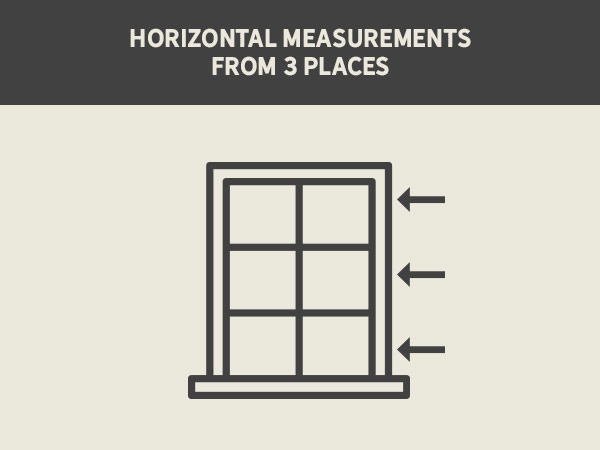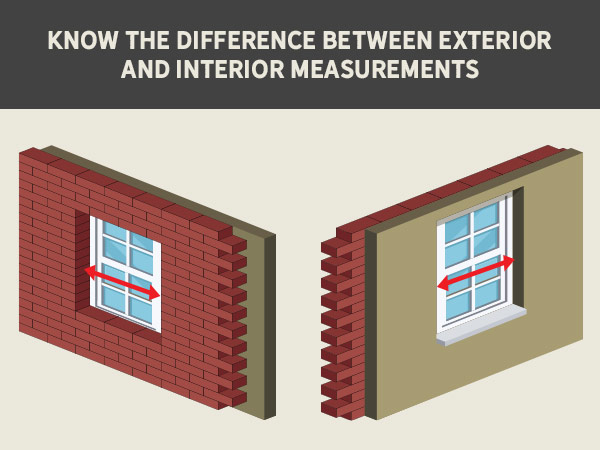

How to Measure for Replacement Windows
You won't be replacing the windows in your home often, but it can be a BIG expense when you do. One way to keep the cost down is to tackle all or part of this home improvement project yourself. While it is a big job, it may not be as daunting as you think!
You can find guidance from McCoy's to help you every step of the way. The first thing you need to know is how to measure for replacement windows.
Make sure you can use a replacement window in your home. Open the window and use a tape measure to measure the distance from the outside of the frame to the inside of the frame to get the depth. While this number won't be included in the window dimensions, you need at least 2 5/8” to 3 1/4" Once you know your depth is at least this amount, you can be confident a replacement window installation is an option for your home. This dimension will also guide you in choosing the type of window.
The Best Way to Measure for Replacement Windows
You may be surprised to learn that the best way to measure for replacement windows is from the outside of your home. (Don't worry, we'll share a hack for what to do if you live in a two-story home.)
With an existing home, you're working with a fixed amount of space for your window openings, also called a rough opening. Unless you're planning on a lot of construction because you want a larger or smaller window than you already have, you'll need the replacement window to fit inside the existing space. Because you probably already have trim around the windows on the inside, the opening is easier to measure on the outside of your house.
Here's what to do. For rectangle openings, you'll measure horizontally across the top, middle, and bottom of the window from one finished edge of your home's exterior (the brick, stucco, or siding) to the other. You'll do the same vertically across the center and to the left and right.
Deduct 1/2" from the smallest horizontal and the smallest vertical measurement of each of those openings. Do this for each window you plan to replace. Don't be surprised as you move from opening to opening that you get slightly different sizes.


How Do I Measure for Replacement Windows in a Two-Story Home?
While you will need a ladder and helper to take your final measurements, there is a way to measure from the inside of your home for estimating purposes. It's called measuring "sheetrock to sheetrock."
Drywall used in residential construction is typically 1/2" thick. Usually, one layer of sheetrock is attached to all four sides of the window opening. By measuring this interior opening and adding the thickness of the sheetrock from both sides (that is, one inch horizontally and one inch vertically), you will generate a number very close to the original framed rough window opening.
The same rule about taking three horizontal measurements and three vertical measurements and using the smallest of each of these applies here.
What's Next in the Process?

Take pictures of the exterior of your home and the interiors of the window. Then, head over to McCoy's with the photo and your measurements. The sales associate can guide you to a window series that suits your needs in terms of style and energy efficiency.
They can also help you calculate something called united inches. This is the sum of the vertical and horizontal measures of the rough opening. A window that's 4 feet by 6 feet would be 120 united inches. That's 4x12=48 plus 6x12=72 for a total of 120.
Most manufacturers bracket their prices so that the pricing of the windows falls into groupings based on united inches. McCoy's will use this number to estimate the total cost of the windows you'll be ordering. We can provide you an estimate on the spot and it will include a picture of the windows you designed and the energy specifications.
You can order your new replacement windows to the nearest 1/8" increment smaller than your measurement. For example, if your smallest measurements on an opening are 35 7/8" x 71 5/8", you would want to order a window that is 35 5/8" x 71 3/8".
Ordering Your Windows at McCoy's
Windows sold at McCoy's are priced so that any white vinyl window under 101 united inches is one price regardless of the callout or rough opening. Sizes above 101 united inches have a nominal surcharge. Additional costs could include an alternative color, a painted exterior, window grids, or a full screen on a double-hung window.
Replacement windows may have thicker frames than your current windows. The frame may extend farther into the interior than your current window does. It's possible you may have to cut back the sheetrock around the window during the installation.
Your existing blinds or shutters may need to be replaced once you complete the project. Some work on the exterior trim may be required as well.
That's why getting an estimate before you order is an essential first step. It will help you establish a budget for the windows themselves as well as any finish work required to get them to look just right in your home.
Measuring for replacement windows and placing the order can be intimidating, but not to worry! We're here to help you make your home more beautiful and energy-efficient. We've heard just about every kind of question and have the answers you need to help select your perfect window. Tackling window replacement yourself can save you $150 or more per window, leaving you lots of green for other projects!
How Do I Measure for Replacement Windows in a Two-Story Home?
While you will need a ladder and helper to take your final measurements, there is a way to measure from the inside of your home for estimating purposes. It's called measuring "sheetrock to sheetrock."
Sheetrock used in residential construction is typically 1/2" thick. Usually, one layer of sheetrock is attached to all four sides of the window opening. By measuring this interior opening and adding the thickness of the sheetrock from both sides (that is, one inch horizontally and one inch vertically), you will generate a number very close to the original framed rough window opening.
The same rule about taking three horizontal measurements and three vertical measurements and using the smallest of each of these applies here.

What's Next in the Process?
Take pictures of the exterior of your home and the interiors of the window. Then, head over to McCoy's with the photo and your measurements. The sales associate can guide you to a window series that suits your needs in terms of style and energy efficiency.
They can also help you calculate something called united inches. This is the sum of the vertical and horizontal measures of the rough opening. A window that's 4 feet by 6 feet would be 120 united inches. That's 4x12=48 plus 6x12=72 for a total of 120.
Most manufacturers bracket their prices so that the pricing of the windows falls into groupings based on united inches. McCoy's will use this number to estimate the total cost of the windows you'll be ordering. We can provide you an estimate on the spot and it will include a picture of the windows you designed and the energy specifications.
You can order your new replacement windows to the nearest 1/8" increment smaller than your measurement. For example, if your smallest measurements on an opening are 35 7/8" x 71 5/8", you would want to order a window that is 35 5/8" x 71 3/8".
Ordering Your Windows at McCoy's
Windows sold at McCoy's are priced so that any white vinyl window under 101 united inches is one price regardless of the callout or rough opening. Sizes above 101 united inches have a nominal surcharge. Additional costs could include an alternative color, a painted exterior, window grids, or a full screen on a double-hung window.
Replacement windows may have thicker frames than your current windows. The frame may extend farther into the interior than your current window does. It's possible you may have to cut back the sheetrock around the window during the installation.
Your existing blinds or shutters may need to be replaced once you complete the project. Some work on the exterior trim may be required as well.
That's why getting an estimate before you order is an essential first step. It will help you establish a budget for the windows themselves as well as any finish work required to get them to look just right in your home.
Measuring for replacement windows and placing the order can be intimidating, but not to worry! We're here to help you make your home more beautiful and energy-efficient. We've heard just about every kind of question and have the answers you need to help select your perfect window. Tackling window replacement yourself can save you $150 or more per window, leaving you lots of green for other projects!
